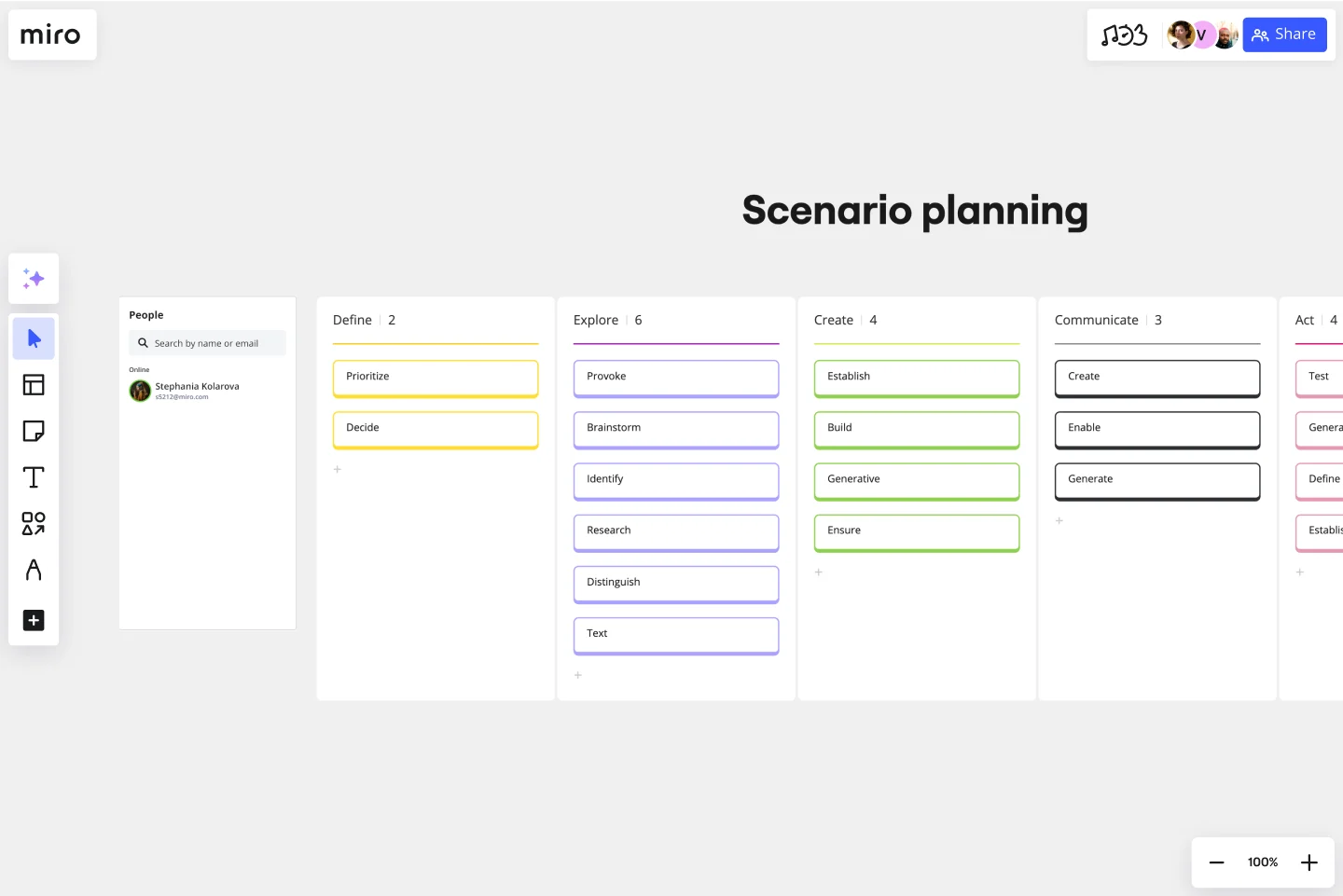Scenario Planning Template
Strategize and see different future scenarios with the scenario planning template. Bring structured thinking to teams and effectively navigate projects.
About the Scenario Planning Template
Use the scenario planning template to streamline your strategizing and ideation processes. Built with clarity in mind, this template brings a structured approach to planning, helping teams and project members navigate the complexities of project planning and execution.
The scenario planning template is a systematic framework to guide people and teams through the process of exploring, creating, communicating, and acting on different future scenarios. The template includes sections to guide you through the entire scenario planning process:
Define: This is the foundation. Here, you'll prioritize and decide on the significant factors and uncertainties impacting your scenarios.
Explore: A space to provoke thought, brainstorm ideas, identify key elements, research, distinguish between different scenarios, and test your assumptions.
Create: Dive into the core of your scenarios. Establish your ground rules, build on your ideas, use generative thinking, and ensure all details are considered.
Communicate: This area focuses on conveying your scenarios to stakeholders, from creating visual aids to enabling understanding and generating feedback.
Act: The final step involves putting your scenarios into play. Test, generate actionable tasks, define responsibilities, and establish a clear course of action.
How to use the scenario planning template in Miro
1. Customize the template: Add the template to a new board, or to an existing one where your project is being scoped. With just a few clicks, easily edit, expand, or change the template sections per your project needs.
2. Add artifacts: Seamlessly integrate artifacts like images, charts, or notes onto the Miro board, enriching your planning process.
3. Collaborate: Invite team members to join the board and collaborate in real time.
4. Save and share: Once done, save your board and share it with relevant stakeholders.
Why use a scenario planning template?
Scenario planning is a useful exercise for envisioning different plausible futures and their potential impacts on a projects goals, operations, and strategies. Using the scenario planning template to guide this process adds structure and clarity to the exercise. Here are just a few benefits to using the template:
Structured thinking: The template provides a logical flow of information, helping to organize thoughts and ideas systematically.
Flexibility: The template is customizable and can cater to various needs, making it suited for a range of projects, from business strategy to creative ventures.
Enhanced collaboration: Designed for teams, it fosters a collaborative environment, promoting shared decision-making.
Efficiency: Filling out the scenario planning template reduces the time to strategize by offering a ready-to-use framework.
Clarity: With clearly demarcated sections, all aspects of scenario planning are covered, reducing the chances of oversight.
Can I customize the template for my specific needs?
Absolutely! The template is fully editable and can be tailored to fit any project requirements.
How many people can collaborate on the template at once?
There's no set limit. Large or small teams can simultaneously collaborate and input their ideas.
Can I use the template for non-business scenarios?
Yes, the scenario planning template is versatile. It can be used in various settings, including creative projects, academic planning, and more.
Get started with this template right now.
Fishbone Diagram for Marketing
Works best for:
Fishbone Diagram
Optimizing marketing strategies requires identifying underlying issues. The Fishbone Diagram Marketing template helps you systematically explore factors affecting your campaigns. Categorize potential causes into areas such as market research, product positioning, promotional strategies, and distribution channels. This structured analysis enables your team to pinpoint and address issues, enhancing marketing effectiveness and achieving better results.
Pros and Cons List Template
Works best for:
Decision Making, Documentation, Strategic Planning
A pros and cons list is a simple but powerful decision-making tool used to help understand both sides of an argument. Pros are listed as arguments in favor of making a particular decision or action. Cons are listed arguments against it. By creating a list that details both sides of the argument, it becomes easier to visualize the potential impact of your decision. To make your pros and cons list even more objective, it can help to weight each pro and con against the others. You can then present your decision with confidence, making a strong argument for why it’s the right one.
Product Thinking Board
Works best for:
Product Management, Planning
Product Thinking Board template encourages a user-centered approach to product development. By fostering empathy, collaboration, and experimentation, this template stimulates innovative thinking and problem-solving. With sections for user research, ideation, and prototyping, it supports iterative product design and validation. This template serves as a visual framework for product teams to engage in user-centric design thinking processes, driving the creation of products that truly meet user needs and deliver exceptional experiences.
Product Discovery Kick Off Workshop
Works best for:
Product Managament, Planning
The Product Discovery Kick Off Workshop template accelerates the start of product discovery initiatives. By facilitating collaborative workshops, defining objectives, and establishing timelines, this template ensures that product discovery efforts are structured and focused. With sections for defining user personas, articulating problem statements, and setting success criteria, it guides teams through the initial stages of product discovery, laying the foundation for successful product development. This template serves as a catalyst for aligning teams and kick-starting product innovation journeys.
Customer Journey Map by Hustle Badger
Works best for:
Customer Journey Map
Customer journey mapping is a method that visualizes and narrates how users navigate a site or app to achieve their objectives.
Gantt Chart for Project Scheduling
Works best for:
Planning, Strategy
Gantt Chart for Project Scheduling helps you plan and visualize project timelines. It enables you to manage tasks, deadlines, and dependencies, ensuring efficient project execution. Ideal for project managers looking to streamline their scheduling process.
